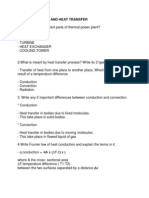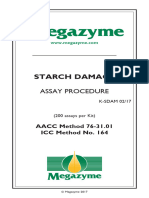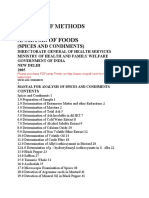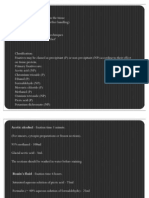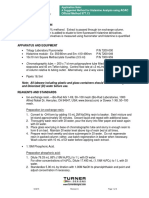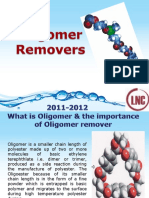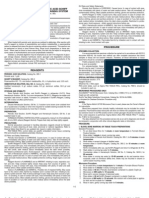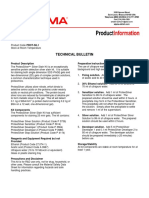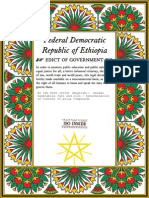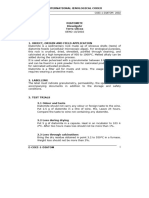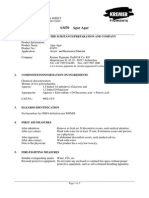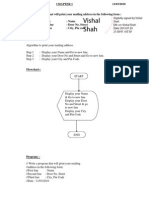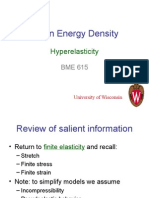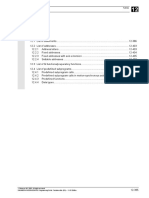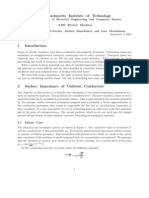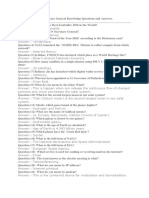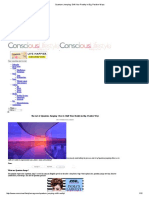Agar - Kremer
Agar - Kremer
Uploaded by
Iljuha9Copyright:
Available Formats
Agar - Kremer
Agar - Kremer
Uploaded by
Iljuha9Copyright
Available Formats
Share this document
Did you find this document useful?
Is this content inappropriate?
Copyright:
Available Formats
Agar - Kremer
Agar - Kremer
Uploaded by
Iljuha9Copyright:
Available Formats
Page 1 von 3
Dr. Georg Kremer, Dipl.-Chemiker, Farbmhle, D-88317 Aichstetten/Allgu, Telefon +49-7565-914480, Telefax +49-7565-1606
kremer-pigmente@t-online.de, www.kremer-pigmente.com
63470 Agar-Agar
Prepared at the 49th JECFA (1997)
superseding specifications prepared at the 44th JECFA (1995), published in FNP 52 Addendum 3 (1995)
SYNONYMS Agar-agar; gelose; Japan agar; Bengal, Ceylon, Chinese or Japanese isinglass; Layor Carang;
INS No. 406
DEFINITION Agar is the dried hydrophilic, colloidal substance extracted from certain marine algae of the
class Rhodophyceae. It is a polysaccharide, consisting primarily of D- and L-galactose units.
About every tenth D-galactopyranose unit contains a sulfate ester group. Calcium,
magnesium, potassium or sodium cations are also associated with the polysaccharide.
C.A.S. number 9002-18-0
Assay Not higher than 0.25% for threshold gel concentration
DESCRIPTION Agar is odourless or has a slight characteristic odour. Unground agar usually occurs in
bundles consisting of thin, membranous, agglutinated strips, or in cut, flaked, granulated or
powdered forms. It may be light yellowish orange, yellowish grey to pale yellow, or
colourless. It is tough when damp, brittle when dry. Powdered agar is white to yellowish
white or pale yellow.
FUNCTIONAL USES Thickener, stabilizer, emulsifier
CHARACTERISTICS
IDENTIFICATION
Solubility Insoluble in cold water; soluble in boiling water
Gel formation with water
Passes test
See description under TESTS
Precipitate formation with ammonium sulfate solution
Passes test
See description under TESTS
Precipitate formation with lead acetate solution
Passes test
See description under TESTS
Microscopy Passes test
See description under TESTS
Page 2 von 3
Dr. Georg Kremer, Dipl.-Chemiker, Farbmhle, D-88317 Aichstetten/Allgu, Telefon +49-7565-914480, Telefax +49-7565-1606
kremer-pigmente@t-online.de, www.kremer-pigmente.com
PURITY
Water absorption Passes test
See description under TESTS
Loss on drying Not more than 22% after drying at 105 until the difference between two weighings is less
than 1 mg (about 5h). Unground agar should be cut into pieces from 2 to 5 mm
2
before
drying.
Total ash Not more than 6.5% on the dried basis
Acid-insoluble ash Not more than 0.5% on the dried basis
Foreign insoluble matter Not more than 1% See description under TESTS
Arsenic Not more than 3 mg/kg (Method II)
Lead Not more than 5 mg/kg Prepare a sample solution as directed for organic compounds in the
Limit Test, using 5 g of lead ion (Pb) in the control
Starch and dextrins Not detectable
See description under TESTS
Gelatin and other proteins
Not detectable
See description under TESTS
Microbiological criteria Total plate count: Not more than 5,000 colonies per gram.
Initially prepare a 10
-1
dilution by adding a 50 g sample to 450 ml of Butterfield's phosphate
buffered dilution water and homogenizing in a high speed blender.
Yeasts and moulds: Not more than 500 colonies per gram
Coliforms: Negative by test
Salmonella: Negative by test
TESTS
IDENTIFICATION
TESTS
Gel formation with water
Prepare a 1.0% solution of the sample in boiling water in a flask and place the flask in water
at 30 for 15 min. A firm, resistant gel is formed. Place the flask in water at 70 for 1 h, the
gel is not molten. When heating the flask at higher temperature than 95, gel is liquefied to
form a clear solution.
Page 3 von 3
Dr. Georg Kremer, Dipl.-Chemiker, Farbmhle, D-88317 Aichstetten/Allgu, Telefon +49-7565-914480, Telefax +49-7565-1606
kremer-pigmente@t-online.de, www.kremer-pigmente.com
Precipitate formation with ammonium sulfate solution
A warm (40) 0.5% solution of the sample gives a precipitate with half its volume of a warm
(40) 40% ammonium sulfate solution. This test distinguishes agar from alginates, gum
arabic, gum ghatti, karaya gum, pectin and tragacanth.
Precipitate formation with lead acetate solution
A warm 0.5% solution of the sample gives a precipitate with one fifth its volume of basic
lead acetate TS. This test distinguishes agar from methyl cellulose.
Microscopy Place a few fragments of unground agar or some powder on a slide and add some drops of
water or chloral hydrate TS. When examined under a microscope, agar in water appears
granular and somewhat filamentous. In chloral hydrate TS, the powdered agar appears more
transparent than in water.
PURITY TESTS
Water absorption Place 5 g of the sample in a 100-ml graduated cylinder, fill to the mark with water, mix, and
allow to stand at 25 for 24 h. Pour the contents of the cylinder through moistened glass
wool, allowing the water to drain into a second 100-ml graduated cylinder. Not more than 75
ml of water should be obtained.
Foreign insoluble matter Boil 5 g of the sample with 500 ml of water and 12 ml of sulfuric acid under a reflux
condenser for 2 h. Allow to cool and filter through a tared, fine, sintered glass crucible. Wash
flask and filter with 50 ml of water, dry at 105 to constant weight and weigh. Calculate as
percentage.
Starch and dextrins To a warm (40) 0.5% solution of the sample, add 2 drops of iodine TS. Where the drops fall,
a red-violet colour appears. After mixing, the solution should be golden brown and not blue
or reddish.
Gelatin and other proteins
To a warm (40) 0.5% solution of the sample add 1 volume of warm (40) picric acid TS. No
turbidity should appear within 10 min.
METHOD OF ASSAY Threshold gel concentration: Prepare serial dilutions of the sample with known solids content
(0.15%, 0.20%, 0.25%, etc.) and place in tubes, 150 mm long by 16 mm internal diameter,
stoppered at both ends. Cool for 1 h at 20-25. Allow cylinders of gel to slide from the tubes
to a level surface. The lowest concentration of gel that resists gravity without rupture for 5-30
sec is the threshold concentration of the sample.
You might also like
- Interview Question of Heat TransferDocument9 pagesInterview Question of Heat Transfermunishd_788% (57)
- Cleapps Recipe BookDocument128 pagesCleapps Recipe BookBenjamín Marc Ridgway de SassouNo ratings yet
- Evonik Eudragit L 100 and Eudragit S 100 Specification Sheet PDFDocument7 pagesEvonik Eudragit L 100 and Eudragit S 100 Specification Sheet PDFpict0% (1)
- Eudragit L 100 and Eudragit S 100: Specification and Test MethodsDocument7 pagesEudragit L 100 and Eudragit S 100: Specification and Test MethodscrackenworldNo ratings yet
- Bubble GirlDocument66 pagesBubble GirlIljuha9No ratings yet
- Chapter 7 Solutions Vector MechanicsDocument48 pagesChapter 7 Solutions Vector MechanicsAditya P Banerjee73% (11)
- AOCS - CD - 8-53 Peroxido Con CLDocument2 pagesAOCS - CD - 8-53 Peroxido Con CLmanuelsnic83% (6)
- Propofol SynthesisDocument8 pagesPropofol SynthesisGiorgos Doukas Karanasios0% (1)
- Masson's Trichrome ProtocolDocument4 pagesMasson's Trichrome Protocolitaimo100% (2)
- PH Euro 3.1.3 PolyolefinesDocument9 pagesPH Euro 3.1.3 Polyolefinesryad bmzaNo ratings yet
- Iodine ValueDocument4 pagesIodine ValueRobert Gilmore100% (4)
- Intensive Kitchen Training Manual (IKTM): INTENSIVE KITCHEN TRAINING MANUALFrom EverandIntensive Kitchen Training Manual (IKTM): INTENSIVE KITCHEN TRAINING MANUALRating: 5 out of 5 stars5/5 (1)
- Om Prakash: Work Experience Term PapersDocument1 pageOm Prakash: Work Experience Term PapersOmNo ratings yet
- Pvelite OutputDocument44 pagesPvelite OutputRam MurtyNo ratings yet
- Navara D40Document576 pagesNavara D40Daniel Stuparek100% (26)
- Materials For SEMDocument3 pagesMaterials For SEMdavidtalhaoNo ratings yet
- SPF CreamDocument3 pagesSPF CreamA.M.ANo ratings yet
- Sodium Alginate TestingDocument2 pagesSodium Alginate TestingImran Anwar50% (2)
- K-Sdam DataDocument12 pagesK-Sdam Data2nmzgbvk6cNo ratings yet
- Parafin SectionsDocument3 pagesParafin SectionsFábio Abade SantosNo ratings yet
- GelCode Blue Stain ReagentDocument4 pagesGelCode Blue Stain ReagentAhammed Abu DilNo ratings yet
- Tinción Plata GelesDocument20 pagesTinción Plata GelesValentina D BrunaNo ratings yet
- Manual of Methods OF Analysis of Foods: (Spices and Condiments)Document24 pagesManual of Methods OF Analysis of Foods: (Spices and Condiments)sureshhmaxNo ratings yet
- MOADocument6 pagesMOAjosewarametalNo ratings yet
- FixativesDocument11 pagesFixativeshenryjack1100% (1)
- Prosedur Kerja Gram StainingDocument2 pagesProsedur Kerja Gram StainingRuthMeylindaMuntheNo ratings yet
- Amylose/ Amylopectin: Assay ProcedureDocument12 pagesAmylose/ Amylopectin: Assay ProcedureAdriannah AdrianNo ratings yet
- Molecular Characterization of Sorghum Using RAPD and ISSR MarkerDocument12 pagesMolecular Characterization of Sorghum Using RAPD and ISSR Markersaikripa121No ratings yet
- Liquid Tin: (MG Cat. No. 421)Document5 pagesLiquid Tin: (MG Cat. No. 421)मेनसन लाखेमरूNo ratings yet
- Alodine T-5900 TdsDocument5 pagesAlodine T-5900 TdsImeblaNo ratings yet
- Kemp TR 375Document3 pagesKemp TR 375S SURESHNo ratings yet
- Scope and Application: Aoac Official Method 977.13Document3 pagesScope and Application: Aoac Official Method 977.13danielpazosNo ratings yet
- Oligomer RemoverDocument12 pagesOligomer RemoverL.N.CHEMICAL INDUSTRY100% (1)
- K-Tsta DataDocument24 pagesK-Tsta DataLorena VillavicencioNo ratings yet
- 2018 Megazyme Procedur K-TSTA AssayDocument24 pages2018 Megazyme Procedur K-TSTA Assayfitri electrikaNo ratings yet
- Pas Sop Sigma AldrichDocument2 pagesPas Sop Sigma AldrichRajeev PareekNo ratings yet
- Muscle - Phosphotungstic Acid-Hematoxylin, Mallory's (Ptah)Document5 pagesMuscle - Phosphotungstic Acid-Hematoxylin, Mallory's (Ptah)TEO COAQUIRANo ratings yet
- Method 1673: Poly (Ethylene Glycol) - 600 by Derivatization and High-Pressure Liquid ChromatographyDocument14 pagesMethod 1673: Poly (Ethylene Glycol) - 600 by Derivatization and High-Pressure Liquid ChromatographyelenitabastosNo ratings yet
- PH Euro 3.1.6Document10 pagesPH Euro 3.1.6ryad bmzaNo ratings yet
- 112Document44 pages112oliboti007No ratings yet
- Technical Bulletin: Proteosilver Silver Stain KitDocument4 pagesTechnical Bulletin: Proteosilver Silver Stain KitAjeng FadillahNo ratings yet
- CatalaseDocument8 pagesCatalaseSudarshan BhattacharjeeNo ratings yet
- Protocole-Acide Lactique K-LATE DATA-Megazyme ENDocument16 pagesProtocole-Acide Lactique K-LATE DATA-Megazyme ENA.j. CâmaraNo ratings yet
- FAQs From Karl Fischer Titration Week MerckDocument5 pagesFAQs From Karl Fischer Titration Week MerckNirmal VanaliyaNo ratings yet
- Tinciones Especiales DiapathDocument66 pagesTinciones Especiales DiapathZainMalikNo ratings yet
- ANA 403 Histochemistry Group1Document8 pagesANA 403 Histochemistry Group1conqueror12345678No ratings yet
- JECFA Carrageenan MonographDocument5 pagesJECFA Carrageenan MonographSurya SaputraNo ratings yet
- Attapulgite From USPDocument2 pagesAttapulgite From USPNofa PuspitaNo ratings yet
- Two GC-MS Methods For The Analysis of Acrylamide in FoodstuffsDocument12 pagesTwo GC-MS Methods For The Analysis of Acrylamide in FoodstuffsSalsabila WiriasasmitaNo ratings yet
- Cfns Experiment 48 - The Blue Bottle ExperimentDocument2 pagesCfns Experiment 48 - The Blue Bottle ExperimentJPNo ratings yet
- Coomassie Blue (R-250, G-250) : Products DescriptionDocument4 pagesCoomassie Blue (R-250, G-250) : Products DescriptionCyberSquare IndiaNo ratings yet
- Agarose Gel Electrophoresis Protocol For RNA: Reagents and Materials: For PreparationDocument2 pagesAgarose Gel Electrophoresis Protocol For RNA: Reagents and Materials: For PreparationlainewellNo ratings yet
- Preparation of TissueDocument16 pagesPreparation of TissueEslam NassarNo ratings yet
- AspirinDocument4 pagesAspiringenelleestremos100% (1)
- Codex For PectinDocument7 pagesCodex For PectinSUMARNI MARNINo ratings yet
- Acid Detergent Fiber Procedure (ADF) : 1. ApplicationDocument4 pagesAcid Detergent Fiber Procedure (ADF) : 1. ApplicationFarai FaustosNo ratings yet
- Biodegradable Films: Based On Partially Hydrolyzed Corn Starch or Potato StarchDocument2 pagesBiodegradable Films: Based On Partially Hydrolyzed Corn Starch or Potato StarchUjak KimiaNo ratings yet
- Homap Health & OTC Manufacturing Associates Pakistan: IslamabadDocument11 pagesHomap Health & OTC Manufacturing Associates Pakistan: IslamabadHafiz Ali shanNo ratings yet
- STD ChlorineDocument30 pagesSTD ChlorineMunawar HussainNo ratings yet
- High Molecular Weight Total DNA Extraction From Plant Tissues For Long Read Sequencing - ForkedDocument4 pagesHigh Molecular Weight Total DNA Extraction From Plant Tissues For Long Read Sequencing - Forkedmoathagh1975No ratings yet
- Iso 8420.2012Document13 pagesIso 8420.2012Viviane SouzaNo ratings yet
- Agarose Gel Electrophoresis Protocol For DNADocument2 pagesAgarose Gel Electrophoresis Protocol For DNAaulianiNo ratings yet
- CODEX OIV DiatomeasDocument3 pagesCODEX OIV DiatomeasKarina PeraltaNo ratings yet
- USP-NF AgarDocument2 pagesUSP-NF AgaryoussufNo ratings yet
- The Chemistry of Dairy Products - A Chemical Analysis of Milk, Cream and ButterFrom EverandThe Chemistry of Dairy Products - A Chemical Analysis of Milk, Cream and ButterNo ratings yet
- Adhesives and CoatingsDocument142 pagesAdhesives and CoatingsIljuha9100% (9)
- Klucel PDFDocument24 pagesKlucel PDFIljuha9100% (1)
- Supelco-15-Chemsta Catalogo Analytical StandarsDocument156 pagesSupelco-15-Chemsta Catalogo Analytical StandarsMariana DíazNo ratings yet
- Klucel - Varnostni List PDFDocument4 pagesKlucel - Varnostni List PDFIljuha9No ratings yet
- Agar - Sigma PDFDocument5 pagesAgar - Sigma PDFIljuha9No ratings yet
- World": LnstructionsDocument7 pagesWorld": LnstructionsIljuha9No ratings yet
- Klucel - Kremer PDFDocument2 pagesKlucel - Kremer PDFIljuha9No ratings yet
- Carbopol - Varnostni List PDFDocument5 pagesCarbopol - Varnostni List PDFIljuha9No ratings yet
- 2013 Expenses: Date Price Item Brand Qty (GR/L) NB Shop PlaceDocument2 pages2013 Expenses: Date Price Item Brand Qty (GR/L) NB Shop PlaceIljuha9No ratings yet
- Write A C Program To Calculate The Sum: Sum 1-x /2!+x /4!-x /6!+x /8!-x /10! Aim: To Calculate Sum 1-x AlgorithmDocument13 pagesWrite A C Program To Calculate The Sum: Sum 1-x /2!+x /4!-x /6!+x /8!-x /10! Aim: To Calculate Sum 1-x AlgorithmIljuha9No ratings yet
- Lecture 1 Introduction To MechatronicsDocument15 pagesLecture 1 Introduction To MechatronicsIljuha9No ratings yet
- Agar - Varnostni ListDocument3 pagesAgar - Varnostni ListIljuha9No ratings yet
- Disclaimer - Cecs TextbooksDocument1 pageDisclaimer - Cecs TextbooksIljuha9No ratings yet
- Lecture 5 Basic MicroprocessorsDocument13 pagesLecture 5 Basic MicroprocessorsIljuha9No ratings yet
- Programming in ANSI C - Balagurusamy (Solutions With Flowchart & Programs)Document227 pagesProgramming in ANSI C - Balagurusamy (Solutions With Flowchart & Programs)michelrojar74% (39)
- Microprocessor Control of Manufacturing Systems and Introduction To MechatronicsDocument31 pagesMicroprocessor Control of Manufacturing Systems and Introduction To MechatronicsIljuha9No ratings yet
- How To Brief A CaseDocument4 pagesHow To Brief A CaseIljuha9No ratings yet
- Microprocessor Control of Manufacturing Systems and Introduction To MechatronicsDocument26 pagesMicroprocessor Control of Manufacturing Systems and Introduction To MechatronicsIljuha9No ratings yet
- Lista Cuvinte 30 ScrisoareDocument1 pageLista Cuvinte 30 ScrisoareIljuha9No ratings yet
- C - Part1 (Introduction To C Language)Document30 pagesC - Part1 (Introduction To C Language)Iljuha9No ratings yet
- Lecture 3 Example of Mechatronic SystemDocument36 pagesLecture 3 Example of Mechatronic SystemIljuha9No ratings yet
- Comm3 Chapter 2Document13 pagesComm3 Chapter 2Iljuha9100% (1)
- Lecture 2 Guild Line of The LectureDocument5 pagesLecture 2 Guild Line of The LectureIljuha9No ratings yet
- Microprocessor Control of Manufacturing Systems and Introduction To MechatronicsDocument43 pagesMicroprocessor Control of Manufacturing Systems and Introduction To MechatronicsIljuha9No ratings yet
- Adsorption of Nitrate Onto Biochar Derived From Agricultural ResidualsDocument7 pagesAdsorption of Nitrate Onto Biochar Derived From Agricultural ResidualsPruthwiraj BokadeNo ratings yet
- Revision Mathematics TDocument5 pagesRevision Mathematics TZuraini ArshadNo ratings yet
- Kinetics of Rigid BodiesDocument195 pagesKinetics of Rigid BodiesDexter F. RamagozaNo ratings yet
- Aerial Robotics Lecture 3A - 1 2-D Quadrotor ControlDocument5 pagesAerial Robotics Lecture 3A - 1 2-D Quadrotor ControlIain McCullochNo ratings yet
- CFD Theory Ansys FluentDocument52 pagesCFD Theory Ansys FluentVatsalya SharmaNo ratings yet
- Strain Energy Density FunctionDocument35 pagesStrain Energy Density Functionsamir_ssh7151No ratings yet
- SINUMERIK 840D/840Di/810D Programming Guide FundamentalsDocument54 pagesSINUMERIK 840D/840Di/810D Programming Guide FundamentalsyetkinNo ratings yet
- Gas LawsDocument7 pagesGas Lawsapi-258903855No ratings yet
- Chapter 3Document14 pagesChapter 3api-3696297No ratings yet
- Induced Vibration HXDocument7 pagesInduced Vibration HXPatricia.PNo ratings yet
- MTLK43ENG5Document17 pagesMTLK43ENG5Abdullah MuhammadNo ratings yet
- Introduction To Engineering MechanicsDocument11 pagesIntroduction To Engineering MechanicsFarieysha Binti Rohzi.No ratings yet
- Lect 7 PoissonDocument60 pagesLect 7 PoissonDEVANSHI MATHUR0% (1)
- Lar 01 PDFDocument4 pagesLar 01 PDFMarjan StevkovskiNo ratings yet
- KOM Unit 1Document100 pagesKOM Unit 1dpksobs100% (1)
- Phys 242 Note SRDocument69 pagesPhys 242 Note SROwen ZhaoNo ratings yet
- Read 100 Easy General Knowledge Questions and Answers Quiz For f6Document21 pagesRead 100 Easy General Knowledge Questions and Answers Quiz For f6erin75% (4)
- Math3160s13-Hw8 Sols PDFDocument3 pagesMath3160s13-Hw8 Sols PDFPei JingNo ratings yet
- 1 T Abilitare TuteleaDocument55 pages1 T Abilitare TuteleaKean PagnaNo ratings yet
- Lect 10Document26 pagesLect 10Aranga0% (1)
- An Introduction To Wave Equations and Solitons - Richard PalaisDocument20 pagesAn Introduction To Wave Equations and Solitons - Richard Palaisdelenda3No ratings yet
- Quantum Jumping - Shift Your Reality in Big, Positive WaysDocument12 pagesQuantum Jumping - Shift Your Reality in Big, Positive WaysSatish67% (3)
- Tin Oxidation State, Depth Profiles of and and Oxygen Diffusivity in Float Glass by M Sssbauer SpectrosDocument9 pagesTin Oxidation State, Depth Profiles of and and Oxygen Diffusivity in Float Glass by M Sssbauer SpectrosNopawit KhamtoNo ratings yet
- Ravanfar, Afrooz PDFDocument81 pagesRavanfar, Afrooz PDFAnas ElshabliNo ratings yet
- Maths Paper1Document4 pagesMaths Paper1AbhishekSahuNo ratings yet
